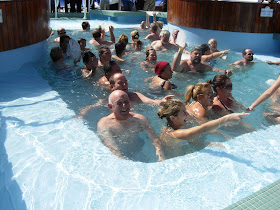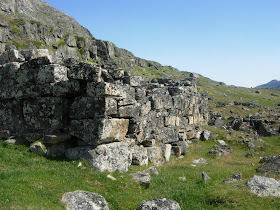




















Green is the "in" color this year, so where else would we go but to Greenland. Greenland, the world's largest island, is about as desolate and isolated as any place can be, but the coast IS green, at least in July. Back in 1946the U.S. offered to buy Greenland for $100 million from Denmark, but the Danes refused to sell. Maybe they thought the best deal is the one you didn't make, but if there was some hidden value, it hasn't been discovered yet. About 85% of the island is a huge glacier, 2 miles thick in some places, draining down into thousands of fjords along the coastline. If all the ice melted, sea levels throughout the world would rise 20 feet, flooding New York and other coastal cities. Fortunately, not much was melting when we visited. According to the locals, the Summer of 2011 has been the coldest in many years.
Geologically, Greenland is part of North America, but politically, it is part of Europe. On this July 30th, we eagerly anticipated cruising through Prinz Christian Sund and watching the great glacier calve off icebergs, but the ship had to cancel this portion of the cruise. It was packed with ice, and the Captain didn't want another Titanic on his watch. Global warming hasn't hit this part of Greenland yet. One passenger remarked that he had taken the cruise 3 times and hasn't been through the Sound yet.
We cruised just outside the ice fields dodging icebergs the size of our ship. Seabirds rested on the ice floes. Spouting whales crossed our path. A Holland-America liner going the other way passed on our starboard (right) side. It was a sunny day with frigid Arctic winds whistling across the deck. It was time for our polar bear party in the ship's pool.
I put on my bathing suit and jumped into the pool with about 30 other hardy souls, which included the ship's entertainers and showgirls. Obviously that made the prospect of freezing to death more tolerable to me. The crew hurled large blocks of ice into the water with us. We were required to stay in the water for 5 minutes. The water was warmer than the air outside, but not much warmer. I had eaten lunch less than 35 minutes before, so my mother would have never allowed me to do this. After the allotted time, I climbed out into the Arctic blasts, and Dianne threw a large towel around me. For a photo session with each swimmer, two crew members dressed as brown(!) polar bears--they didn't have any white costumes. But I earned that coveted certificate for the polar bear club.
The following day we docked outside Q-Town, Qaqortoq, Greenland, which was formerly known as Julianehaab (after the dowager queen of Frederik V of Norway). Qaqortoq is an Inuit word meaning "the white place" which aptly describes it for most of the year. The name actually comes from the white granite found in the area. When Greenland became independent, they changed many place names to reflect the Inuit heritage of most of the people. The whole country has only 55,000 people on an island the size of South America (if you look at a flat world map). Greenland is actually much smaller on a globe, but it's still bigger than Alaska and Texas combined.
We didn't expect much in Qaqortoq, a town of 3,600, the fourth largest city in Greenland. The ship had no excursions available. Brightly colored red, blue and yellow houses were placed in a semi-circle around the harbor like an amphitheater. Most of the few cars in town were taxis. They can't drive very far because there is less than 100 miles of roads in the whole country, and most of that is a few hundred miles North at the capital city, Nuuk. Our ship was too big to dock, so we tendered in to port, about 3/4 of a mile from the ship.
We walked around a little and then went into the visitors' center where they had a few boat tours available. We signed up for a ride on a 30 foot boat with a capacity of 10 passengers. Our cruise director had warned us not to take any local boat tours because they were deemed unsafe and unreliable. But, hey, it was the only game in town! Three of the passengers with us were Greenlandic Danes who spoke good English and told us about life in Greenland.
The captain and assistant were Inuit (Eskimos), and they were dressed in shorts and t-shirts for the Arctic Summer. As the tourists bundled up with hoods and gloves, the crew thought it was warm because the temperature was above freezing, though not much above. Since the boat was small, we could sail close to the icebergs, most of which were larger than the boat. You can break off pure 1000 year old ice to mix in your drink.
We sailed up the fjord for almost an hour amidst the ice floes. Our destination was the ruins of Hvalsey ("whale island"), the Viking settlement which was disbanded in the 1400's because of climate change. It got too cold to farm, and they didn't learn anything from the Eskimo culture which might have helped them to survive. When the Vikings weren't out raping and pillaging, they were setting up small farms and churches. Farming in Greenland was difficult because of the short growing season and poor soil, so even in relatively mild years, their operations were marginal. They harvested hay for the livestock to eat during the long winters.
We landed at Hvalsey which we thought was uninhabited, but we soon encountered sheep roaming through the area. Clumps of their wool got caught in the brambles in many places, and Dianne scooped up handfuls to take home. The few farmers left in Greenland mainly raise sheep for a marginal existence, but they also raise reindeer and a few chickens and horses.
Even with a longer growing season, growing crops would be difficult because of the huge boulders strewn around the countryside, deposited by the glaciers. The Vikings gathered many of them up and built a sturdy church and a few houses with rock and stone walls. The stone houses were covered with roofs made of turf which are now long gone. There are no trees, but many shrubs and much plant life. The meadow was rich with colorful wildflowers. We picked our way through and over the rocks to the top of the hill overlooking the ruins and the rocky beach. The pier where we docked the boat is about 10 feet high, and you have to climb a ladder to go ashore. The reason is that the tides are extremely high.
Our boat drove several more miles through the fjord to visit the Upernaviarsuk Agricultural Station, with an ag school, experimental farm and greenhouse. In this protected area, they grow flowers, vegetables and trees, hoping to establish some farming and allowing the people to be self-sufficient, at least for some commodities. Although they grow bananas in Iceland, Greenland is another story.
As we sped back to port on the boat, we almost crashed into another boat which crossed in front of us. The two Inuit boat captains were shouting obscenities at each other in Greenlandic with the appropriate hand gestures. I don't normally understand Greenlandic, but I understood them very well. These guys are cowboys behind the wheel.
We wandered around Qaqortoq for awhile, visiting Brugseni, the supermarket chain which is the Greenland version of WalMart. We found it to be remarkably well stocked with many American consumer goods as well as local favorites like seal blubber and whale meat which are said to prevent cardiovascular disease. Although Greenland exports mostly fish, the Inuit eat relatively little fish, but prefer the above, as well as potatoes and canned vegetables. Many drink Cult Cola, the "World's Strongest Cola" promoted in the Brugseni flyer. Greenland also brews "ice cap" beer which is brewed with the extra pure water from icebergs--Craft Brewed Greenland Beer. They export much of it to Denmark.
NEXT: Newfoundland and St. Pierre & Miquelon
No comments:
Post a Comment